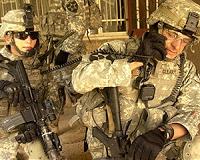| . |  |
. |
Barksdale AFB LA (SPX) Feb 03, 2010 Air Force Global Strike Command officials here assumed responsibility for the Air Force's nuclear-capable bomber force Feb. 1. This action completes the step-by-step transfer of all Air Force long-range, nuclear-capable assets to the Air Force's newest major command. The nation's intercontinental ballistic missile force became part of Air Force Global Strike Command on Dec. 1, 2009. The command staff will gain the 8th Air Force and its three bomb wings, one each at Barksdale Air Force Base, Whiteman AFB, Mo.; and Minot AFB, N.D. Those organizations control all of the B-52 Stratofortress and B-2 Spirit bombers and are transitioning from Air Combat Command as a key component of the Air Force's "Nuclear Roadmap." "We've worked very closely with Gen. William M. Fraser III and his ACC team every step of the way," said Lt. Gen. Frank G. Klotz, the AFGSC commander. "They have been truly magnificent partners in this endeavor. Even after Feb. 1, we'll still have strong and long-standing ties to ACC as we work closely with them in their special role as lead command for the Combat Air Forces." The transfer once again places all Air Force assets with a strategic nuclear deterrence and global strike mission - missiles and bombers - under one command. This action will provide for "more focused and effective oversight of this important and enduring mission," General Klotz said. The general also noted that the bombers of 8th Air Force "remain critically important to our nation, as well as to our friends and allies around the world." The B-52 provides "unique, unmatched stand-off capabilities," and the B-2 has the ability to attack heavily defended targets, he said. "Both bombers also offer combatant commanders important non-nuclear, or conventional, capabilities as they so convincingly demonstrated in both Operation Enduring Freedom and in Operation Iraqi Freedom." To mark the transfer of the bomber mission to Air Force Global Strike Command, General Klotz is scheduled to visit all three bomber bases on Feb. 1. He will be accompanied by Maj. Gen. Floyd L. Carpenter, the commander of 8th Air Force, and Chief Master Sgt. Jack Johnson Jr., the AFGSC command chief. At each of the bases, the leaders will conduct a basewide commander's call to formally welcome the Airmen into the command. They will also meet separately with unit commanders and their first sergeants, civic leaders and local media representatives. The addition of the bomber units brings Air Force Global Strike Command's force to more than 23,000 people, with about 900 full-time staff expected at the Barksdale AFB headquarters by the end of summer. Air Force Global Strike Command stood up in August to provide combat-ready forces to conduct nuclear deterrence and global strike operations in support of the president and combatant commanders. When the command took over the ICBM mission Dec. 1, it gained the 20th Air Force mission, with missile wings at Malmstrom AFB, Mont., F.E. Warren AFB, Wyo., and Minot AFB, N.D. The command also gained the 576th Flight Test Squadron at Vandenberg AFB, Calif., and the 625th Strategic Operations Squadron at Offutt AFB, Neb.
Share This Article With Planet Earth
Related Links US Air Force Read the latest in Military Space Communications Technology at SpaceWar.com
 Raytheon Offers Disruption-Tolerant Military Network
Raytheon Offers Disruption-Tolerant Military NetworkCambridge MA (SPX) Feb 02, 2010 Raytheon BBN Technologies demonstrated the successful transmission of voice and data across a wireless mobile ad hoc network that was in a constant state of flux, mimicking the communications challenges that military networks confront in tactical use. These results mark milestone achievements for the Wireless Network After Next (WNaN) program, which is sponsored by the Defense Advanced Res ... read more |
|
| The content herein, unless otherwise known to be public domain, are Copyright 1995-2010 - SpaceDaily. AFP and UPI Wire Stories are copyright Agence France-Presse and United Press International. ESA Portal Reports are copyright European Space Agency. All NASA sourced material is public domain. Additional copyrights may apply in whole or part to other bona fide parties. Advertising does not imply endorsement,agreement or approval of any opinions, statements or information provided by SpaceDaily on any Web page published or hosted by SpaceDaily. Privacy Statement |